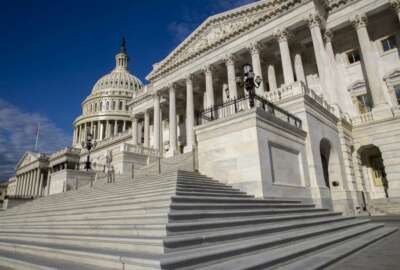
Civilian agency cuts in House spending bill are deep, not as drastic as Trump’s proposal
Some civilian agencies were spared from deep cuts included in the president's budget request, but the IRS and EPA would see significant reductions.
Just one week after lawmakers passed a continuing resolution that would keep the government open until Dec. 8, House lawmakers passed a 2018 spending package that includes all 12 appropriations bills.
The House passed the $1.2 trillion spending bill with a 211-198 vote. It includes $621.5 billion in base defense spending and $511 billion for non-defense discretionary spending, in addition to $87 billion in total for the Overseas Contingency Operations fund.
It’s the first time since 2009 the House collectively passed all of its appropriations bills in one way or another.
Lawmakers merged the remaining eight appropriations bills with a “minibus” package that the House passed shortly before leaving town for the August recess.
Even before the House finished work on the remaining eight appropriations bills, budget experts said the “minibus,” which set appropriations for the departments of Defense, Energy, Interior, Veterans Affairs and other agencies, as well as the legislative branch, had little chance of Senate passage.
The final version of the House bill sets defense spending at $60 billion higher than current enacted levels and $30 billion higher than President Donald Trump’s budget. Those topline numbers exceed the spending caps set in the Budget Control Act of 2011 and would trigger sequestration.
The bill also sets aside $1.6 billion for the initial planning and construction of a wall along the U.S. southern border. For those reasons and others, budget experts said the House budget has little chance of survival.
The Senate is much further behind the House in its appropriations and budget process. The chamber hasn’t passed any of the 12 appropriations bills, and Senate appropriators have yet to move all spending packages out of committee.
Lawmakers have until Dec. 8 now to pass some sort of spending bill before the current continuing resolution expires.
Under the House plan, many civilian agencies would see spending cuts — but not quite as drastic as the cuts included in the president’s 2018 budget proposal.
The House budget, for example, includes nearly $9 billion for medical research at the National Institutes of Health, ignoring the president’s recommendations to implement sharp cuts at the agency.
Some law enforcement agencies and NASA also received a small spending bump.
In addition, lawmakers voted to prohibit agencies from using funds to plan, continue, finish or approve a “public-private competition to determine whether federal civilian jobs should be outsourced.”
Agencies were also spared from last-minute proposals that called for across-the-board cuts to administrative expenses and salaries at several civilian agencies.
Rep. Paul Mitchell (R-Mich.) introduced three amendments that offered 10 percent cuts at the Commerce and Justice Departments, the Labor, Health and Human Services and Education Departments and agencies in the financial services and general government division.
One amendment never made it the House floor and the other two were rejected by a voice vote.
Other civilian agencies couldn’t avoid major spending cuts.
Bad news for EPA
The House spending bill includes $7.5 billion for the EPA, $534 million below fiscal 2017 enacted levels, bringing the agency’s budget in line with 2006 spending levels.
It “supports the president’s proposal to reshape the agency’s workforce by providing resources requested to offer buyouts and voluntary separation agreements to employees,” the Interior and Environment Committee’s appropriations summary reads.
The House also slashed federal accounts on studying climate change. Other provisions prevent EPA from enforcing the agency’s methane rule, for example.
Some lawmakers attempted to prohibit any funds from being used to close or consolidate EPA regional offices, but amendments didn’t pass.
Another provision prevents EPA from hiring new employees under a special pay authority intended to hire public health professionals at HHS.
More cuts for the IRS
The IRS would receive $11.1 billion, $149 million less than fiscal 2017 enacted levels but $111 million higher than what the president requested.
The House 2018 number is close to the amount IRS Commissioner John Koskinen told Senate appropriators he’d need to maintain current current performance levels and a 79 percent customer phone service response rate during the most recent tax filing season.
Still, the House 2018 bill holds the IRS budget to 2008 funding levels, and they’ve been steadily declining since 2010.
The House measure does boost funding for some of the agency’s functions, including IRS operations support and cybersecurity and information technology.
“Included in the base bill are funds to support IRS’ customer service — such as phone call and correspondence response times — and funding for fraud prevention and cybersecurity,” the House Financial Services and General Government Committee wrote in a summary of its appropriations bill.
As in the past, the House spending bill includes provisions that ensure IRS employees follow existing rules on performance and conduct and restrictions on targeting specific groups.
Tighter budgets for GSA
The bill also includes a little less than $8 billion for the General Services Administration’s Federal Buildings Fund, nearly $2 billion less than what the agency requested.
It also includes $20 million for GSA to create an Asset Proceeds and Space Management Fund, half of the administration’s request of $40 million. The revolving fund is designed to help agencies update or sell off under-utilized or vacant federal buildings.
The bill provides no appropriations for construction and acquisition.
Other agencies under the Financial Services and General Government Committee’s jurisdiction would also see cuts.
The Office of Personnel Management would receive nearly $20 million less for IT modernization. OPM had originally requested $37 million to update its IT systems, particularly to transfer its retirement claims processing system to a paperless one.
Copyright © 2025 Federal News Network. All rights reserved. This website is not intended for users located within the European Economic Area.
Nicole Ogrysko is a reporter for Federal News Network focusing on the federal workforce and federal pay and benefits.
Follow @nogryskoWFED





